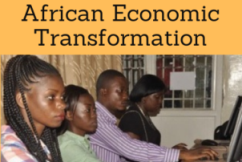African Economic Transformation, Tripartite
Module: African Economic Transformation (African Mining Vision. Industrial Sector, Agriculture)

African Population in 2030: 1.6 billion people (today: 1 billion people).
African share of total manufacturing output of the World: 1.5% (Europe: 25%, Latin America: 6%, Asia-Pacific: 22%).
Five subjects compose the Training “African Economic Transformation. African Industrial Sector” offered by EENI Global Business School:

- African Green Growth Initiative
- African Mining Vision (AMV)
- African Industrial Sector. Industrial Policy
- Investment Role in the African economic transformation
- African agriculture sector
Sample - African Economic Transformation



- Credits: 5

- Duration: 5 weeks It is recommended to dedicate about twelve hours of study per week following a flexible schedule. It is possible to reduce the duration dedicating more hours a week
- Download the syllabus (PDF)
Languages: 
- Also available in For improving international communication skills, student has free access to the learning materials in these languages (free multilingual training).
 Transformation économique de l’Afrique
Transformation économique de l’Afrique  Transformação econômica africana
Transformação econômica africana  Transformación económica africana
Transformación económica africana
The Online training “African Economic Transformation” belongs to the following Higher Education Programs offered by EENI:
Doctorate in African Business.


The goals of the course are the following:
- To learn about “African Green Growth Initiative” of the African Union based on a sustainable and inclusive economic model for Africa
- To understand the fundamental importance of the “African Mining Vision” designed with the objective that the huge African mineral resources would be one of the key pillars of African Economic Transformation
- To analyze the “African Industrial Sector,” identifying their strengths, weaknesses, opportunities, and threats in the global/regional market, as well the strategy for implementation of the Action Plan for the Accelerated Industrial Development of Africa
- To analyze the Investments Role in African Economic Transformation
Course intended for all those wishing to understand the deep African Economic Transformation.
The Subject 1- African Green Growth Initiative. Syllabus:
- Introduction to the African Green Growth Initiative
- Green Growth in Africa
- Role of African Countries in green economic growth
- Need for a sustainable infrastructure
- Proficient and sustainable natural resources administration
- Physical, economic, and social elasticity
- Role of the African Development Bank
The Subject 2- African Mining Vision (AMV). Syllabus:
- Introduction to the African Mining Vision (African Union)
- African natural resources improvement
- Commodities trading
- Need for the African mining vision
- Key factors for realizing the African Mining Vision
- Quality and level of resource potential
- Capacity to negotiate contracts
- Incomplete African resources development
- Wholly state-owned mining projects reduction
- Infrastructures improvement
- African Development Corridors
- Framework for action
- African Minerals Development Centre (AMDC)
- Minerals and African Development
- Africa Review Report on mining
The Subject 3- African Industrial Sector. Syllabus:
- Introduction to African Industrial Sector
- New opportunities for African manufacturing sector
- Made in Africa Brand
- Division of Industry of the African Union
- Industrial policy in Africa
- Industrial sector and structural transformation in Africa
- Industrial policy frameworks
- Public and private sector
- Strategy for implementation of the Action Plan for the Accelerated Industrial Development of Africa
- Case Study:
- Kenya: National Industrial Policy
- Mauritius: transformation of a country based on mono-crop into a middle-income economy
- Industrialization in Nigeria and Tunisia
- Industrial performance of Rwanda
- Industrial policy in South Africa. Automotive Industry
The Subject 4- Investment Role in African transformation. Syllabus:
- Investment, transformation, and development in Africa
- Trends and investment patterns in Africa
- Composition of investments
- Decline of public investment
- Factors for investing in Africa
- Access to credit and cost of finance
- Low domestic savings
- Risk and uncertainty
- Inequality and aggregate demand
- Policy and investment environment
Sample:
Sample:
- Near 61% of the African population earn less than two dollars per day
- Africa imports 39 billion dollars in foodstuff every year
- African people living without access to electricity: 600 million
The vision of the African Development Bank on the African Green Growth Initiative is to promote an inclusive economic growth investing in sustainable infrastructures, enhancing natural resources and disasters management and improving African food security.
Weaknesses of African Green Growth:
- Inadequate infrastructures: low access to energy, high Tariffs, urbanization, education, and health
- Natural resources management (renewable and non-renewable), deforestation
- Climate change and natural disaster
- Food security, rising food prices, low productivity. African food production in 2050: increment of 70%
African Manufacturing Production
- In the last decade, capacity of African manufacturing production has been doubled
- New economic relationships with Emerging Markets (China, India, Brazil)
- In the last ten years, China was the largest manufactured goods provider to Africa
- Trends in African manufacturing sector: labour-intensive production of basic goods. By example, the African Growth and Opportunity Act (AGOA) for labour-intensive export textile products to the United States Market
- High commodity prices
- strategic role of special economic zones (employments, technology transfer, value addition)
(c) EENI Global Business School (1995-2025)
Top of this page








 WhatsApp
WhatsApp